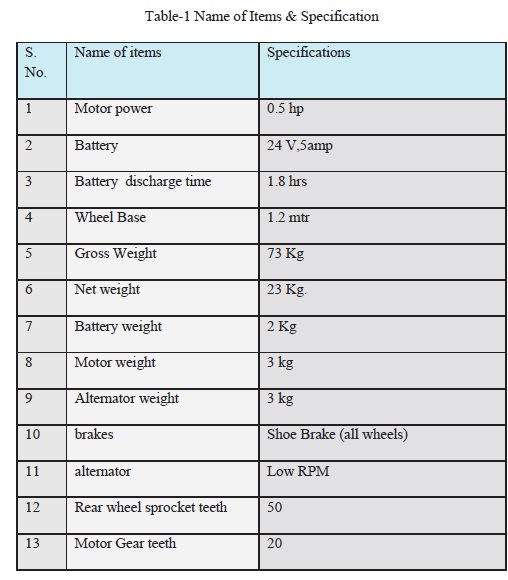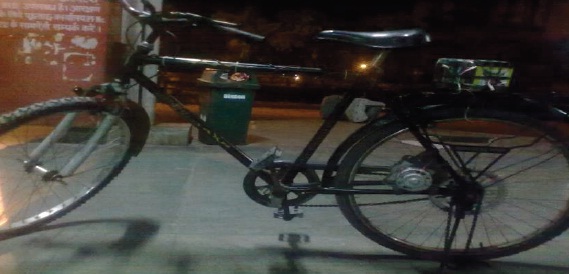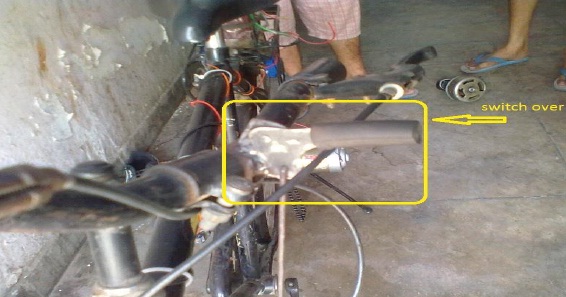





Published on Feb 28, 2025
With the increase in fuel prices, pollution content in atmosphere and due to gradual end of the non renewable sources of energy we have to alter the source of our energy in our vehicles. Considering all these reasons we have to switch over to other sources of energy instead of using conventional sources such as petrol which in future will be going to extinct. One way to alter the energy source is to go for electric vehicles or e bikes. Electric driven vehicles uses battery as a source of energy which provide power to motor which in turn provide torque to wheels .
The old design of electric bicycle was having only a single mode of charging, it was just capable to travel 15 km through battery and was not ergonomically good. The new design uses a low rpm alternator for charging the battery by keeping it in contact with front wheel .A Motor of 0.5hp provides torque to the rear wheel and the gear ratio is kept 5:2 .battery discharging time is approximately 2 hrs and charging time through alternator is 1 hour and the bicycle can attain a maximum speed of 15 km/hr. This work is more beneficial in hilly region and confined areas like college campus and schools, generating zero pollution, zero noise effect and no fuel consumption.
Bicycles are one of the most ubiquitous forms of transportation in the world. Most children remember their first bike; with it came the chance to explore their world with more freedom than ever before. As we grow, however, bicycling becomes more than just a childhood rite of passage. Wind in our hair and feet on the pedals, we have several good reasons to climb on and take a trip. Much of the world uses bicycles as a primary form of daily transportation. What would take several hours of travel on foot becomes faster and more efficient on two wheels. Some cyclists take trips across entire states or cross-country solely on a bicycle.
Reaching speeds of 15 miles or 30 km an hour is achievable by even beginning cyclists, while more experienced riders can reach speeds equivalent to automobile travel. "Century riders" travel 100 miles or more within a typical day. Not to be constrained by simple transportation, bicycles (stationary and otherwise) have helped people become healthier by losing excess weight and improving cardiovascular fitness. The exercise benefits of cycling are well known. Using the largest muscles in the body, bicycling allows riders to reach aerobic heart rates that drive up metabolism, and give a good workout.
With the relative newcomer in the bicycle world, mountain bikes, this form of transportation is taking us on rugged terrain once thought impassable by anything other than hiking boots or pack animals. Extreme sport enthusiasts have adapted the bicycle to perform gravity defying stunts, such as flips and mid air acrobatics, in a style known as BMX (Bicycle Motorcross). In short, bikes remain a popular way to get people between points A and B, whether those destinations are found on a map, from one state of health to another, or to explore the unknown. Bicycles have become an important part of the landscape. Most people understand the saying, "as easy as riding a bike." Or we understand that some dormant skill is easy to pick back up if it's "just like riding a bike." Likewise, many immediately think of bicycles when we make an allusion to "coasting", "picking up speed", or "going downhill".
Because of technological advances in storage cells and electric propulsion systems in recent years and in response to the growing demand for clean, efficient methods of transportation in our urban communities, electric bicycle development and marketing has surged ahead, especially in Asia and Europe.. E-bikes are not a replacement for conventional bicycles. However, they allow a greater number of people to travel on two-wheeled vehicles. In the future, they could evenbecome a means of locomotion that could substitute for the automobile, particularly inwarmer weather.
E-bikes are for everybody, especially those who are not very active in sports, those with physical disabilities and seniors. They are also for veteran cyclists who commute to work on conventional bicycles to save money on fuel but wish to avoid arriving at the office covered in perspiration.Growth in e-bike use has skyrocketed since the electrically assisted bicycle (EAB) was introduced in 1997 by the Japanese firm Yamaha.
This version of the e-bike has a small motor mounted on the back wheel to double the power generated by the cyclist. In 1998, the company scored a major commercial success by selling 500,000 units worldwide, making Japan the e-bike market leader. The European market is growing as well, with more than 100,000 units sold in 1999. However, there are no clear, standardized regulations for all European Economic Community countries.
There are many possible types of electric motorized bicycles with several technologies available, varying in cost and complexity; direct-drive and geared motor units are both used. An electric power-assist system may be added to almost any pedal cycle using chain drive, belt drive, hub motors or friction drive. BLDC hub motors are a common modern design with the motor built into the wheel hub itself and the stator fixed solidly to the axle and the magnets attached to and rotating with the wheel. The bicycle wheel hub is the motor. The power levels of motors used are influenced by available legal categories and are often, but not always limited to under 750 watts. On our bicycle we use 24 volt 5 Amp motor with 0 .5 Hp for better performance and low out put velocity (10-20 kmph).
Electric bicycles use rechargeable batteries, electric motors and some form of control. Electric bicycles developed in Switzerland in the late 1980s for the Tour de Sol solar vehicle race came with solar charging stations but these were later fixed on roofs and connected so as to feed into the electric mains.The bicycles were then charged from the mains, as is common today. Battery systems in use include lead-acid, NiCd, NiMH and Li-ion batteries. Range is a key consideration with electric bikes, and is affected by factors such as motor efficiency, battery capacity, efficiency of the driving electronics, aerodynamics, hills and weight of the bike and rider.
The range of an electric bike is usually stated as somewhere between 7 km (uphill on electric power only) to 70 km (minimum assistance) and is highly dependent on whether or not the bike is tested on flat roads or hills The energy costs of operating electric bicycles are small, but there can be considerable battery replacement costs. Riding an electric bicycle to work or to the store instead of taking a car has long term financial and health gains. From lots of given option we selected 2 lead acid batteries of 12 volt 5 amp because of its easy availability and low cost and connected in series to get an output of 24 volt.
Control can be as simple as an on-off switch but more usually they are power-on-demand, where the motor is activated by a handlebar mounted throttle, and/or a pedelec (from pedal electric), also known as electric assist, where the electric motor is regulated by pedaling. These have a sensor to detect the pedaling speed, the pedaling force, or both. Brake activation is sometimes sensed to disable the motor as well. There are two distinct types of electric bike controllers designed to match either a brush or brushless motor. Brushless motors are becoming more common as the cost of controllers continues to decrease.
The page on DC motor covers the differences between the two types. Electric bicycles require high initial torque and therefore models that use brushless motors typically have Hall sensor commutation for speed measurement. An electronic controller provides assistance as a function of the sensor inputs, the vehicle speed and the required force. The controllers generally provide potentiometer-adjustable motor speed, closed-loop speed control for precise speed regulation, protection logic for over-voltage, over-current and thermal protection.
The controller uses pulse width modulation to regulate the power to the motor. Sometimes support is provided for regenerative braking but infrequent braking and the low mass of bicycles limits recovered energy. An implementation is described in an application note for a 200 W, 24 V Brushless DC (BLDC) motor. Brush motors are also used in electric bikes but are becoming less common due to their intrinsic lower efficiency. Controllers for brush motors however are much simpler and cheaper due to the fact they don't require hall sensor feedback and are typically designed to be open-loop controllers.
An alternator is an electromechanical device that converts mechanical energy to electrical energy in the form of alternating current. The brushes in an alternator carry only excitation current, a small fraction of the current carried by the brushes of a DC generator, which carry the generator's entire output. A set of rectifiers (diode bridge) is required to convert AC to DC. To provide direct current with low ripple, a three-phase winding is used and the polepieces of the rotor are shaped (claw-pole) to produce a waveform similar to a square wave instead of a sinusoid. We have used alternator of Yamaha bike which works at high RPM since our e-bicycle is limited to low RPM so we altered the windings of alternator and increases the drive ratio. So, that it can function at low RPM.
Not all electric bicycles take the form of conventional push-bikes with an incorporated motor, such as the cytronex bicycles which use a small battery disguised as a water bottle. Some are designed to take the appearance of low capacity motorcycles, but smaller in size and consisting of an electric motor rather than a petrol engine. Our design used the concept of rear wheel drive which gets torque from motor Which in turn gets power by battery of 24 volts,5 ampere. in this design along with the charging of battery through main source it is also charged through alternator which is driven by front wheel friction drive working effectively in down hills Making it a dual rechargeable bicycle and thus useful in many areas specially college campuses, hospitals where noise pollution is not acceptable

The motor uses a gear ratio of 5:2.The rear shaft is driven by a 50 teeth chain drive which is rotated by a 20 teeths gear driven by motor. Motor power is 0.5hp/373 watts. The motor gets power by a combination of 2 battery 12 volts 5 ampere connected in series conbination. Sprocket is connected through welding on rear hub. The motor is mounted on 3 mm steel sheet by 8mm bolt. For self charging alternator is capable of producing 3.09watt when we are moving at 10 km/hr which is driven by front wheel.

Switch over which is used to engage / disengage the alternator is manually controlled and is made of iron rod, steel sheet and a link. it is a kind of a lever. The switch over to self charging is achieved by the use of lever which is manually controlled

The majority of the cost of the initial prototype is found in the price of the motor, bicycle, battery and alternator. We are expecting however that almost all bicycle would be constructed from second hand parts, such that the cost would not be prohibitive. The motor and alternator, which are the main part of the bicycle used in our design, is usually much more resilient and remains functional after long run. Taking all these factors into account, the maximum component price for the dual chargeable electric bicycle is estimated to be around Rs 12000.
— Economic benefits.
— Eco friendly.
— Low accidental risk.
— Save of fuel resources.
— Easy handling.
— More efficient.
— Less effort more power.
— Benificial for hilly region
· No pollution
· No need for charging in EB supply
· No gear, carburetor, engine, etc.
· No starting troubles
· Noise level is very low.
· No need external energy supply
· Easy opera table
The following conclusions can be drawn from the present study
· When the battery is fully charged a speed of 10-15km/hr is obtained.
· When comming down the hill the charging can be achieved in 1hr.
· Because of friction driven mechanism wheel wear at a faster rate.
1. Khurmi R.S. & Gupta J.K., Theory of machines, S.chand, Delhi, 2008
2. McGurn, Jim. (1999). On Your Bicycle: The Illustrated Story of Cycling. York, U.K.: Open Road.
3. Wilson, David Gordon. (1977). ‘‘Human muscle power in history.’’ In Pedal Power, ed. James C.McCullagh. Emmaus, Penn.: Rodale.
4. Sharp, Archibald. (1896). Bicycles and Tricycles. London: Longmans, Green; Reprint, Cambridge: MIT Press, 1977.
5. Vijay Gupta “The bicycle story” publishes by Vigyan Prasar